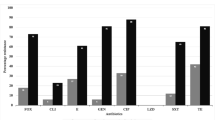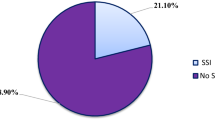Summary
A 6-month prospective surveillance was conducted in the Department of General Surgery of the Rio de Janeiro University Hospital. Postoperative infections were classified according to CDC criteria. This study reports a significant rate (16.9%) in surgical infections detected by surveillance in a series where 45% of surgical interventions were classified as clean. The majority (52.7%) was apparent only after patient discharge from the hospital. Bacterial cultures were obtained from 42 out of 55 infected wounds.Staphylococcus aureus was the most frequently found pathogen (33.9%), followed byEscherichia coli (20.3%). With the exception ofS. aureus isolates, multiresistance was found in 66% of coagulase-negative staphylococci and 60% of gram-negative bacteria. This study showed that community surveillance associated with hospital surveillance is necessary in order to determine accurate rates of surgical site infections, and also showed that the emergence of multiresistant bacterial strains was common among isolates of surgical infections.
Similar content being viewed by others
References
Wenzel, R. P. The economics of nosocomial infections. J. Hosp. Infect. 21 (1995) 79–88.
Haley, R. W., Gaynes, R. P., Aber, R. C., Bennett, J. V. Surveillance of nosocomial infection. In:Bennett, J. V., Brachman, P. S. (eds): Hospital infections. 3rd ed. Little, Brown & Co., Boston 1992, pp. 79–108.
Mayhall, C. G. Surgical infections including burns. In:Wenzel, R. P. (ed): Prevention and control of nosocomial infections. 2nd ed. Williams & Wilkins, Baltimore 1993, pp. 614–644.
Byrne, D. J., Lynch, W., Napier, A., Davey, P., Make, M. E., Cushieri, A. Wound infection rates: the importance of definition and postdischarge wound surveillance. J. Hosp. Infect. 26 (1994) 37–43.
Wilson, A. P. R. Surveillance of wound infections. J. Hosp. Infect. 29 (1995) 81–86.
Horan, T. C., Gaynes, R. P., Martone, W. J., Jarvis, W. R., Emori, T. G. CDC definitions of nosocomial surgical site infections, 1992. A modification of CDC definitions of surgical wound infections. Infect. Control Hosp. Epidemiol. 13 (1992) 606–608.
Brown, R. B., Bradley, S., Opitz, E., Cipriani, D., Pieczarka, R., Sands, M. Surgical wound infections documented after hospital discharge. Am. J. Infect. Control 10 (1982) 60–64.
Holtz, T. H., Wenzel, R. P. Postdischarge surveillance for nosocomial wound infection: A brief review and commentary. Am. J. Infect. Control 20 (1992) 206–213.
Horan, T. C., Culver, D. H., Gaynes, R. P., Jarvis, W. R., Edwards, J. R., Reid, C. Nosocomial infections in surgical patients in the United States, January 1986 – June 1992. Infect. Control Hosp. Epidemiol. 14 (1993) 73–80.
Culver, D. H., Horan, T. C., Gaynes, R. P., Martone, W. J., Jarvis, W. R., Emori, T. G., Banerjee, S. N., Edwards, J. R., Tolson, J. S., Henderson, T. S., Hughes, J. M. Surgical wound infection and rates by wound class, operative procedure, and patient risk index. Am. J. Med. 91 (Suppl. 3B) (1991) 152S-157S.
Ballows, A., Hausler Jr, W. J., Hermann, K. L., Isenberg, H. D., Shadomy, H. J. Manual of clinical microbiology. 5th ed. American Society for Microbiology, Washington, DC, 1991.
National Committee for Clinical Laboratory Standards: Performance standards for antimicrobial disk susceptibility tests. 5th ed. Approved Standard NCCLS Document M2-A5. Villanova, Pa. 1993.
National Committee for Clinical Laboratory Standards Methods for dilution antimicrobial susceptibility tests for bacteria that grow aerobically. 3rd ed. Approved Standard NCCLS Document M7-A3. Villanova, Pa. 1993.
Nichols, R. L. Surveillance of the surgical wound. Infect. Control Hosp. Epidemiol. 11 (1990) 513–514.
Ferraz, E. M., Bacelar, T. S., Aguiar, J. L. A., Ferraz, A. A. B., Pagnossin, G., Batista, J. E. M. Wound infection rates in clean surgery: A potentially misleading risk classification. Infect. Control Hosp. Epidemiol. 13 (1992) 457–461.
Cruse, P. Wound infection surveillance. Rev. Infect. Dis. 3 (1981) 734–737.
Emmerson, A. M., Enstone, J. E., Grifin, M., Kelsey, M. C., Smith, E. T. M. The second national prevalence survey of infections in hospitals — overview of the results. J. Hosp. Infect. 32 (1996) 175–190.
Santos, K. R. N., Bravo-Neto, G. P., Fonseca, L. S., Gontijo-Filho, P. P.: Surveillance in hernia surgery during hospitalization and after discharge in a university hospital. J. Hosp. Infect. (1997) In press.
Horan, T. C., Culver, D. H., Jarvis, W. R., Emori, T. G., Banerjee, S. N., Martone, W. J., Thornsberry, C. Pathogens causing nosocomial infection: preliminary data from the National Nosocomial Infection Surveillance System. Antimicrobic Newsletter 5 (1988) 65–67.
Pollock, A. V., Evans, W. M. Microbiological prediction of abdominal surgical wound infection. Arch. Surg. 122 (1983) 33–37.
Twum-Danso, K., Grant, C., Al-Sidermam, S. A., Khadar-Abdel, S., Si-Anami, M. S., Brerki-Ai, H., Taha, S., Ashoor, A. A., Wosorm, L. Microbiology of postoperative wound infection: a prospective study of 1,770 wounds. J. Hosp. Infect. 21 (1991) 29–37.
Goetz, M. B., Mulligan, M. E., Kwok, R., O'Brien, H., Caballes, C., Garcia, J. P. Management and epidemiology analyses of an outbreak due to methicillin-resistantStaphylococcus aureus. Am. J. Med. 92 (1992) 607–614.
Santos, K. R. N., Fonseca, L. S., Gontijo-Filho, P. P. Emergence of high-level mupirocin resistance in methicillin-resistantStaphylococcus aureus isolated from Brazilian university hospitals. Infect. Control Hosp. Epidemiol. 17 (1996) 813–816.
Schaberg, D. R., Culver, D. H., Gaynes, R. P. Major trends in the microbial etiology of nosocomial infection. Am. J. Med. 91 (Suppl. 3B) (1991) 72S-75S.
Banerjee, S. N., Emori, T. G., Culver, D. H., Gaynes, R. P., Jarvis, W. R., Tolson, J. S., Henderson, T. S., Martone, W. J. Secular trends in nosocomial primary bloodstream infections in the US, 1980–1989. Am. J. Med. 91 (Suppl. 3B) (1991) 86S-89S.
Pannuti, C. S., Grimbaum, R. S. An overview of nosocomial infection control in Brazil. Infect. Control Hosp. Epidemiol. 16 (1995) 170–174.
Author information
Authors and Affiliations
Rights and permissions
About this article
Cite this article
Santos, K.R.N., Fonseca, L.S., Bravo Neto, G.P. et al. Surgical site infection: Rates, etiology and resistance patterns to antimicrobials among strains isolated at rio de janeiro university hospital. Infection 25, 217–220 (1997). https://doi.org/10.1007/BF01713147
Received:
Accepted:
Issue Date:
DOI: https://doi.org/10.1007/BF01713147




